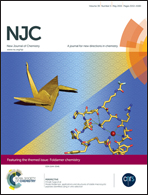Tuning the topology structures of polymolybdate-based hybrids from interpenetrated framework to interdigitated architecture via changing polymolybdate clusters†
Abstract
By introducing different polyoxomolybdates into a Cu–bimb system (bimb = 1,4-bis(imidazol-1-yl) benzene), three new polyoxomolybdate-based inorganic–organic hybrids with distinct architectures, [CuII(bimb)1.5(H2O)(β-Mo8O26)0.5] (1), (Hbimb)2[CuI(bimb)(PMo12O40)]·4H2O (2) and [CuI4(bimb)4(SiMo12O40)]·2H2O (3), have been synthesized under identical hydrothermal conditions and characterized by routine methods. Compound 1 displays an interesting 2-fold interpenetrated structure consisting of two identical layers. When the polyoxomolybdate clusters were changed from β-[Mo8O26]4− to [PMo12O40]3−, and [SiMo12O40]4−, compounds 2 and 3, respectively, were obtained. Compound 2 shows a highly opened three-dimensional framework, while compound 3 exhibits a three-dimensional interdigitated architecture. The different structural features of compounds 1–3 suggest that the influences of different polyoxometalate clusters on structure must play a key role in the process of assembling. Additionally, both the luminescent and electrochemical properties for 1–3 have been investigated.


 Please wait while we load your content...
Please wait while we load your content...